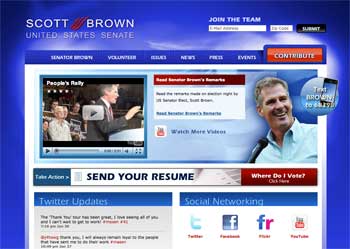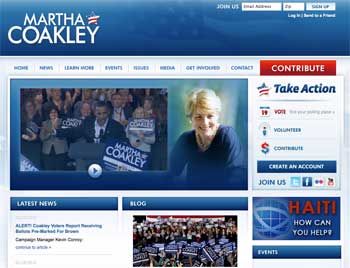His January 19th win shocked the political world, but Scott Brown’s victory came as little surprise to marketing experts tracking social media numbers. Scott Brown’s historic success demonstrates how social media’s underlying principles of human behavior can help you win customers.
What social media reveals quickly
Traditional polls were all over the map in the Massachusetts campaign’s final days. But, social media numbers tabulated by the Wordstream Internet Marketing blog turned out to be the most accurate in predicting the election’s outcome. What if you had this kind of advantage in your business?
Scott Brown’s social advantage over Martha Coakley
- 10:1 advantage in web traffic
- 10:1 advantage in YouTube viewership
- 3:1 advantage in twitter followers
- 4:1 advantage in Facebook followers
Democrats had dominated the web since Howard Dean made revolutionary use of it during his presidential run. But, the technical edge is narrowing. Last month, for example, Republican congressmen sent out 529% more tweets than their Democrat counterparts. Recently, 500 conservatives gathered with Newt Gingrich for workshops on effective use of social media. Here’s the catch: it takes more than a flurry of activity to drive success in politics or business.
Mark Senak, a Democrat, theorizes in his report “Twongress: The Power of Twitter in Congress,” that Democrats are paying less attention to resources that proved critical to Obama’s win even as Republicans make significant gains. Nothing creates results like sustained effort. In social media, competency in doingness is often mistaken for mastery of beingness. True success is less about what you do than who you are; social media just exposes the truth more quickly.
How do you campaign for customers?
Scott Brown’s win had less to do with social media than how he connected with something deep in the hearts of voters: they wanted to be heard. He looked them in the eye and said, “you’re not just another brick in the wall.”
 As my partner Roy H. Williams says, he “spoke to the dog in the language of the dog about what’s in the heart of the dog.”
As my partner Roy H. Williams says, he “spoke to the dog in the language of the dog about what’s in the heart of the dog.”
That’s connecting with a true felt need. Comparing how Brown and Coakley were able to “speak dog” offers clues for how you can better connect with your customers.
Be different where it counts
While both candidates reached out via traditional and social media, Scott Brown did it better. Compare their websites. Brown’s social media elements jump out, as do ways to get involved. Coakley’s links are lost in a traffic jam of graphics.
 Other subtle differences: Brown’s blue is deeper, more pure. Coakley’s blue seems pale by comparison. Pure is strong. Pale is weak.
Other subtle differences: Brown’s blue is deeper, more pure. Coakley’s blue seems pale by comparison. Pure is strong. Pale is weak.
Brown’s photo is an action shot taken from a low angle; you look up at him. He seems bigger than life. Coakley’s is a posed portrait shot from a high angle; you look down at her. She is diminished. Up is good. Down is bad.
Brown’s video shows him campaigning. Coakley’s video is Obama campaigning. Brown is engaged. Coakley’s along for the ride.
Doing little things right gets big results
While such distinctions seem small, they send a message to customers. Your marketing, especially your social media, will be successful only to the degree you’re willing to authentically connect with your customer’s felt need.
Saying you’re connected and demonstrating it are different matters. Being real demands sustained effort to create trust and credibility.Voters and customers can smell a fake even over dial-up. Twittering once every week or so is worse than not doing it at all. Ditto with intermittent blog and Facebook posts.
Social Media opens a door; what you do with it determines if anyone comes in. Whether they stick around is a reflection of how real you’re perceived as being.
Whether it’s social media, traditional media, or person-to-person interaction, since time began, all people want is connectedness, recognition, and appreciation. Scott Brown was able to provide that. Martha Coakley didn’t.
Which campaign trail seems a better path for you?
